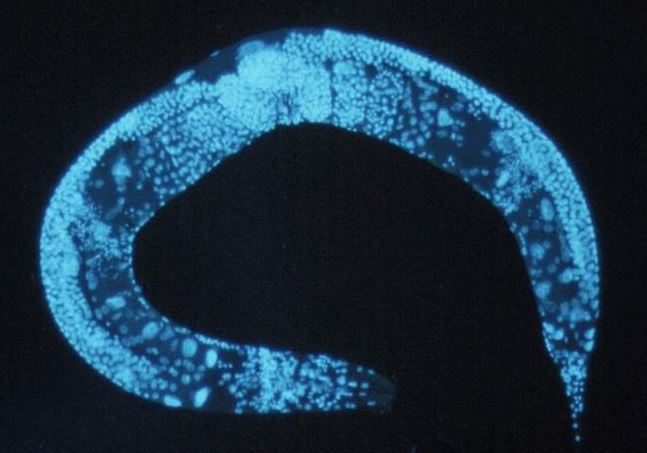Caenorhabditis elegans is a small, unsegmented, transparent member of the order Rhabditida in the phylum Nematoda (Nemata). Measuring approximately 1 millimeter in length in its adult form, this roundworm is typically found in soil, often feeding on bacteria among rotting vegetation and decaying organic matter, and is nonparasitic (free living) and nonpathogenic. Despite being a primitive invertebrate, C. elegans possesses many of the anatomical features and organs found in higher-level animals, such as those pertaining to its nervous, reproductive, muscular, and digestive systems; however, it lacks a circulatory system and a respiratory system. Because C. elegans is transparent, easily observed and manipulated, has a relatively short life cycle (2–3 weeks), and can be cultivated in large numbers under laboratory conditions (with 10,000 nematodes per petri dish), researchers frequently use it to study questions that would be difficult to explore directly in humans and other animals. In particular, because the cells of C. elegans hold steady in number and position in the body throughout its life, it is a popular model organism in developmental biology, embryology, genetics, and neuroscience. See also: Developmental biology; Developmental genetics; Embryology; Genetics; Invertebrate embryology; Nemata (Nematoda); Nervous system (invertebrate); Rhabditida

Caenorhabditis elegans was the first multicellular eukaryote to have its whole genome sequenced. Researchers initially deciphered it in 1998 and finalized it in 2002. The roundworm's genome was found to contain approximately 21,000 protein-encoding genes (a number close to the roughly 20,000–25,000 in humans, with one-third of the genes found in C. elegans having a direct human homolog). These genes are incorporated in more than 100 million base pairs of DNA (in contrast, the human genome contains about 3.3 billion base pairs). Furthermore, the six chromosomes found in C. elegans are structurally similar to human chromosomes, enabling notable comparisons of function and activity. Analyses of the genome have also aided investigators studying the process of aging. In fact, a number of single-gene mutations have been observed to dramatically increase the life span of the nematode, providing genetic clues related to functional decline and senescence in old age. See also: Aging; Cell division; Cell lineage; Cell senescence; Chromosome; Gene; Genetic influences on aging; Genetic mapping; Human genetics; Human genome; Mutation





